How to Find WooCommerce Returning Customers & Improve Customer Retention
When it comes to conversion rate, your WooCommerce returning customers are the most valuable type of customers. There are many studies that show the value of returning customers.
According to a study by CMSWire, whenever a customer buys a product from your store, he is likelier to repurchase it. Buyers who make a single purchase have a 27% chance of making a second one. With every additional purchase, the chances of another purchase are increasing. When someone has bought from your store for the fourth time, there’s a 59% chance they’ll return.
Returning Customer Definition
A returning customer is a customer who has made more than one purchase from the store within a specified period. The returning customer rate is a metric that measures the percentage of total visits from repeat customers, indicating the business’s ability to retain its existing clients and achieve long-term growth and profitability.
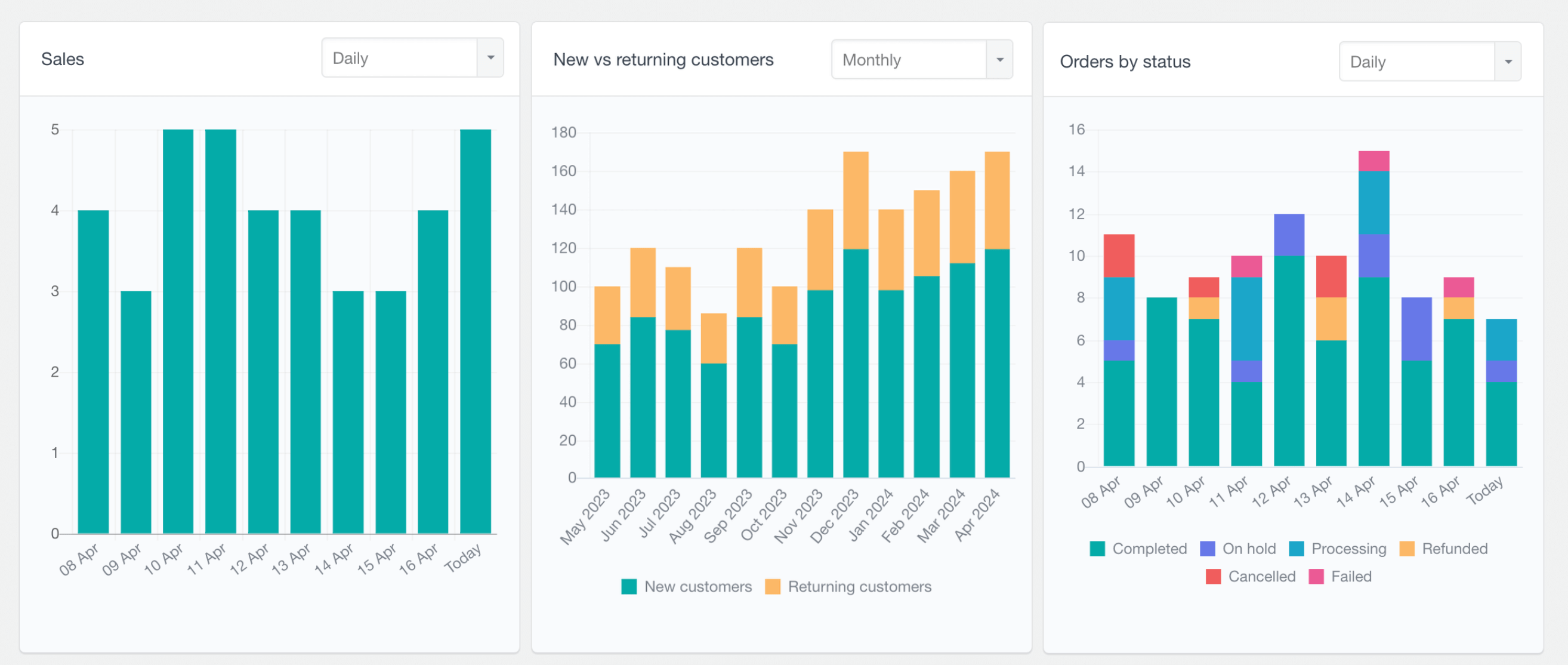
The Value of Loyal Customers
According to their study, returning customers make between 25% and 40% of the total sales annually. Some studies claim that attracting a new customer costs your business between five and twenty-five times as much as keeping an existing one.
Attracting a new customer, costs your business between five and twenty-five times as much as keeping an existing one.
To put it simply, if you bring back a first-time customer to buy again, they are more likely to become loyal customers.
WooCommerce customer retention
WooCommerce customer retention is the ability of a company to retain its customers over a specified period. If a company has high customer retention, that means its customers continue to rebuy the same products or new products, re-subscribe to the same services, or, in some other way, continue buying from that company and increasing the average order value. It is a critical metric that measures the percentage of total purchases from repeat customers, indicating the business’s ability to retain its existing clients and achieve long-term growth and profitability.
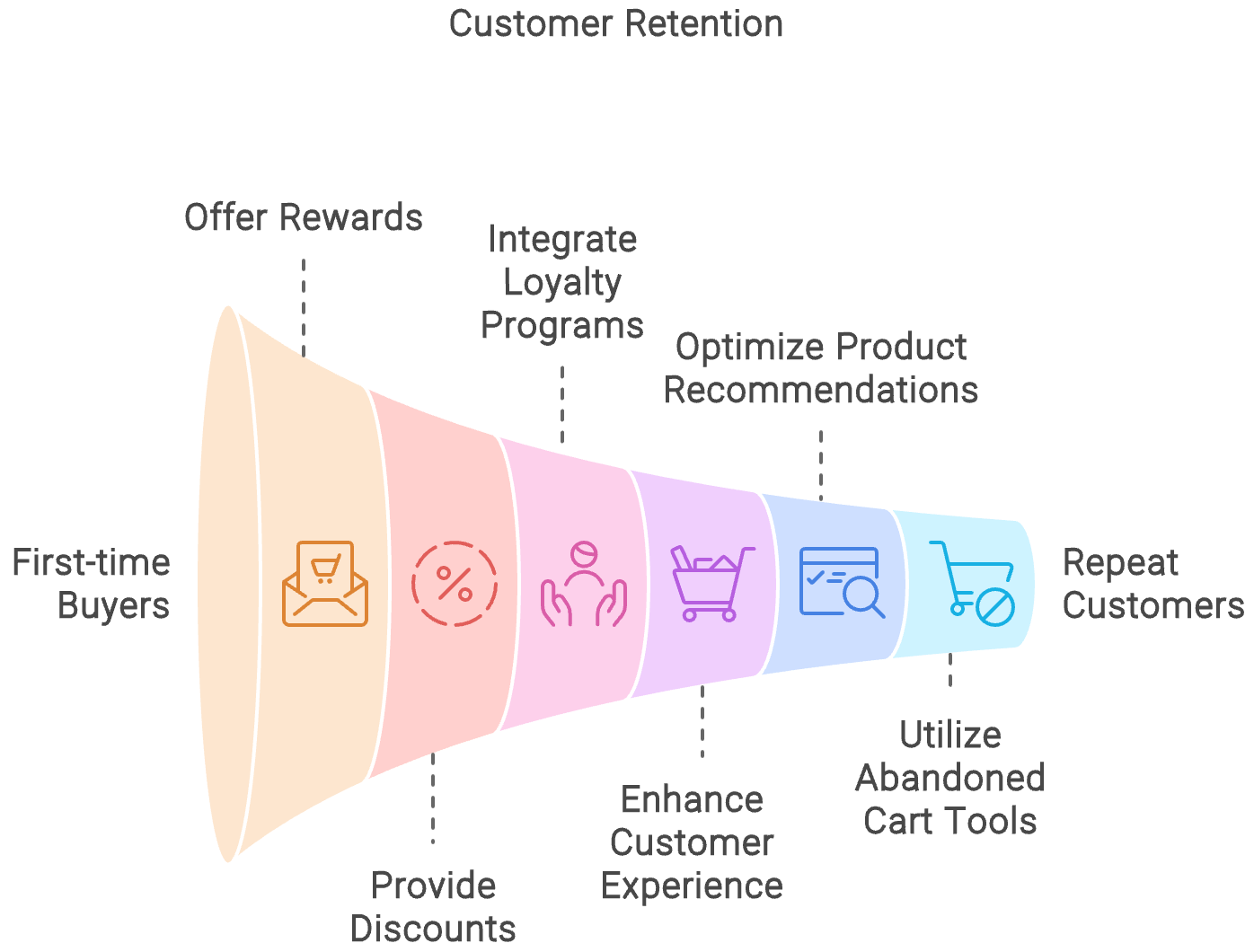
You can do many things to convince first-time buyers to make a second purchase and improve your customer retention. These include:
- rewards for multiple purchases,
- customer discounts and coupons, and
- loyalty programs integration,
- improving the customer experience and checkout process,
- better product recommendations,
- using abandoned cart email tools and
- marketing automation, and
- better customer service. etc
But before you even try to implement any of those techniques, you need a way to separate first-time buyers from already loyal customers.
Retaining existing customers is much less expensive than acquiring new ones. Existing customers are already familiar with your products and services and have some level of trust in your business. When targeting existing customers, you will not only save resources on customer acquisition but also reduce costs for customer education and training. This is why it is important to know your customer purchase history.
Returning customers are also a lot more profitable. According to a study by Adobe, only 8% of returning customers are responsible for 40% of the eCommerce revenue in the USA.
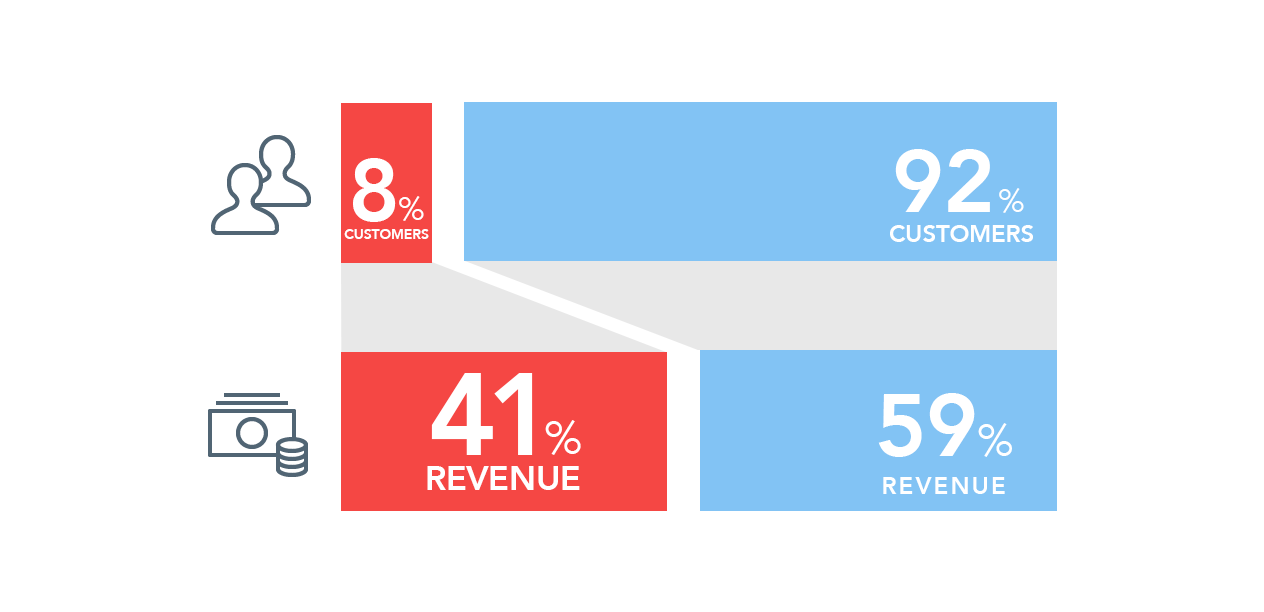
As you can see, knowing who your returning customers are can be very important for your online shop’s success. If you are running a WooCommerce shop, you have probably noticed that there isn’t an easy way to find your most active/returning customers. This is where the Users Insights plugin comes in. With the WooCommerce module, you can analyze your registered WordPress user’s data and find the most active buyers on your online store. The WooCommerce module tracks the Number of orders the users have made and the Last order date. It also adds the ability to filter the users by the products ordered or their order statuses, as well as the new vs. returning customers report.
Finding your New vs Returning WooCommerce customers
Another critical piece of information about your returning customers is the proportion of all your customers. You might need to find how many of your WooCommerce customers are one-time buyers and how many are repeat customers. With the New vs. returning customers report, you can easily track this metric right from the Users Insights custom dashboard in the WordPress admin.
New vs. returning customers report
The New vs. Returning customers report shows the total number of customers over time with color-coded sections for new and returning customers.
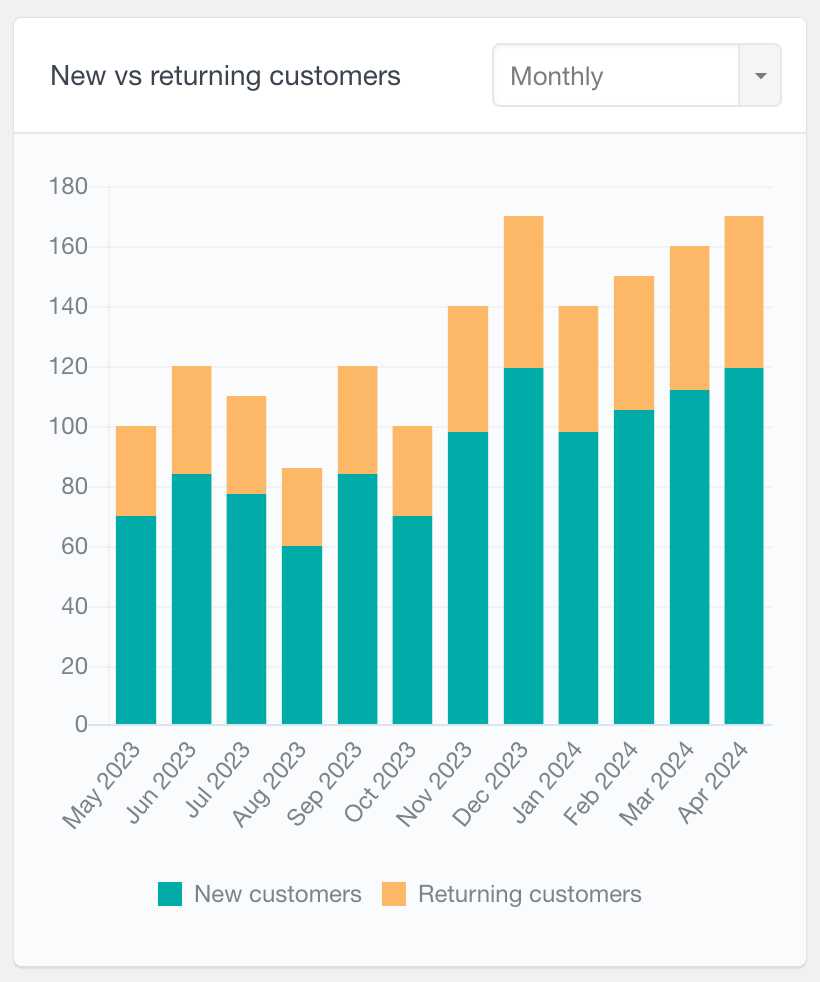
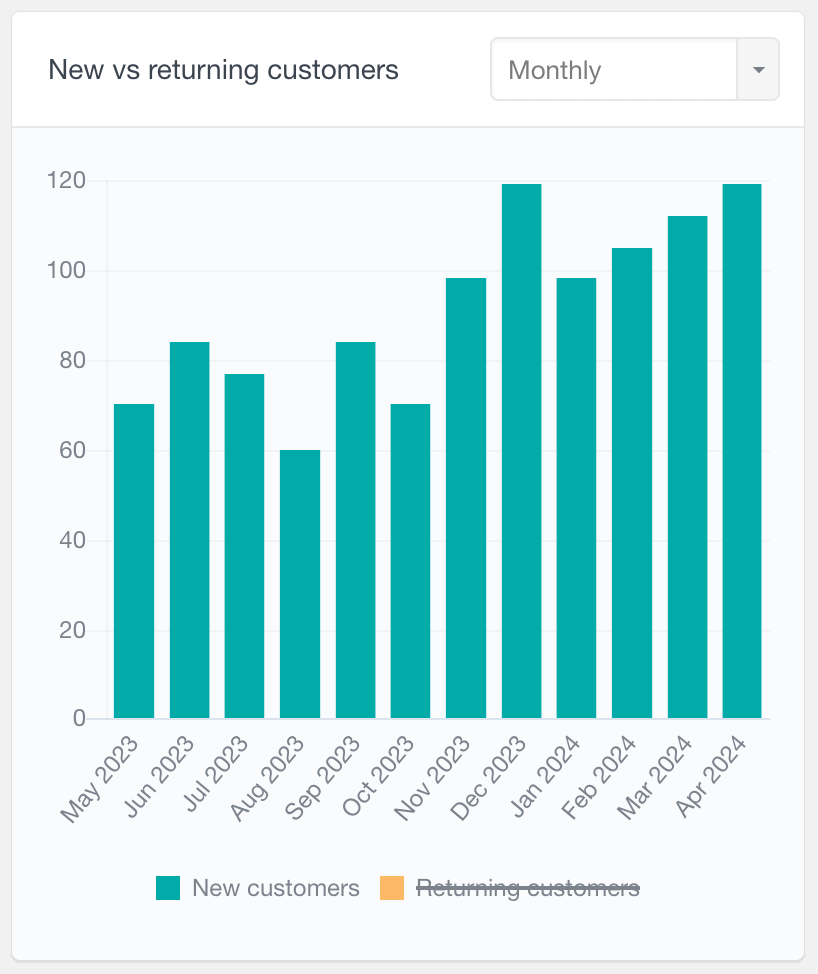
You can view data across different time frames – daily, weekly, monthly or yearly. The interactive labels also allow you to toggle the visibility of each customer group.
Number of orders per customer chart
With the Number of orders per customer chart, you can quickly see the number of orders distributed. Additionally, you can filter this chart to count only the completed orders with order status completed. In this way, you can easily visualize the proportion of new customers (users with one order) vs returning customers (users with 2+ orders).
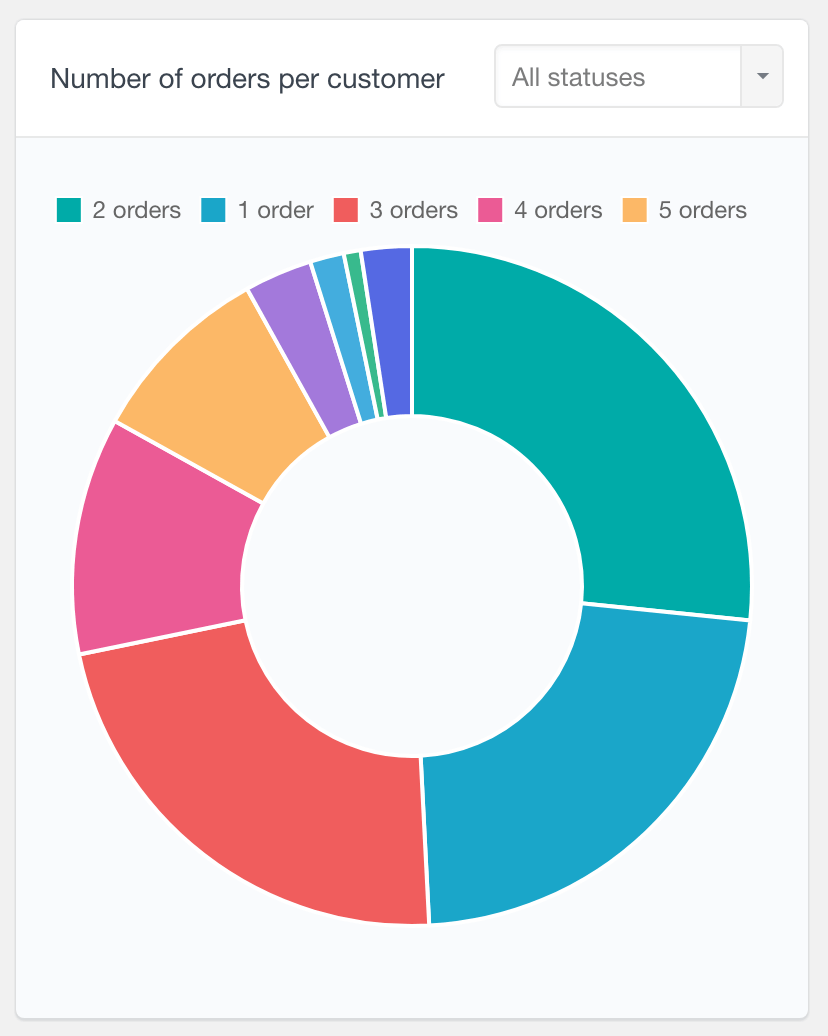
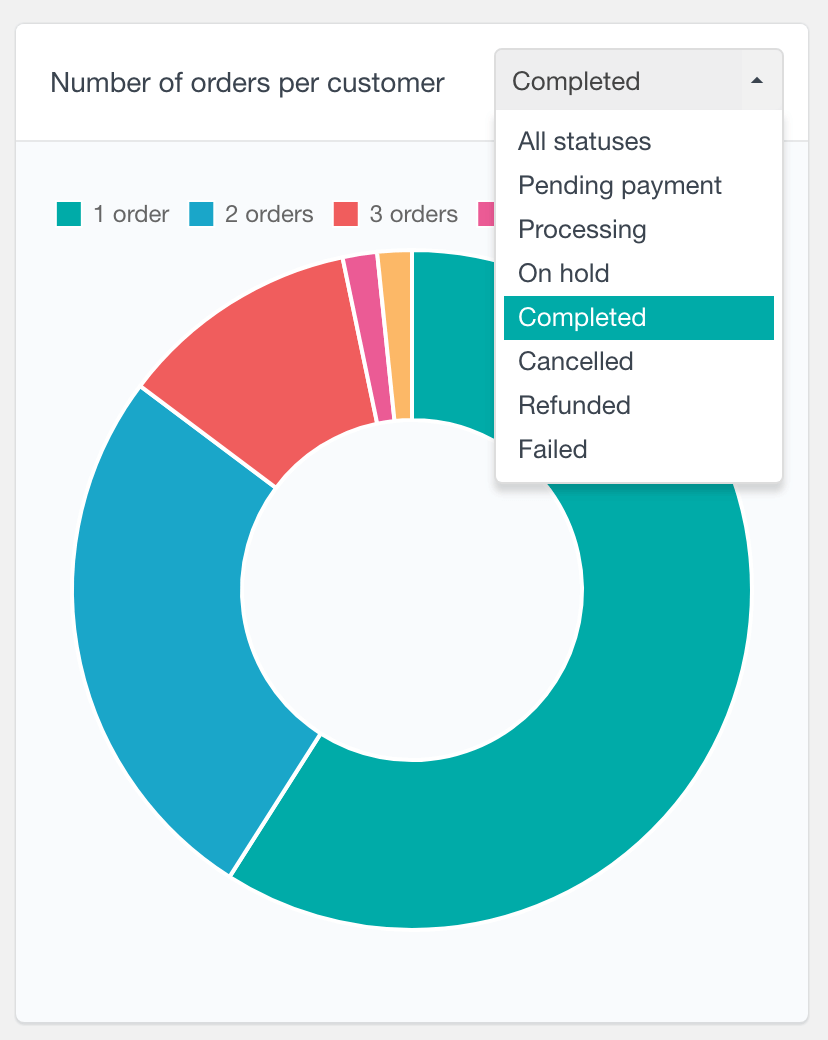
New vs. returning customers user list
A more detailed approach would be to use the Users Insights table and filters. In this way, we can see the number of new/returning customers who they are and apply additional filters if needed.
One way to do that is using the “Successful orders” filter. To do that, we’ll need to find:
- total number of all customers – users with one or more successful orders (greater than 0); in this case, it is 117
- number of returning customers – users with two or more successful orders (greater than 1), which is 74 in this example
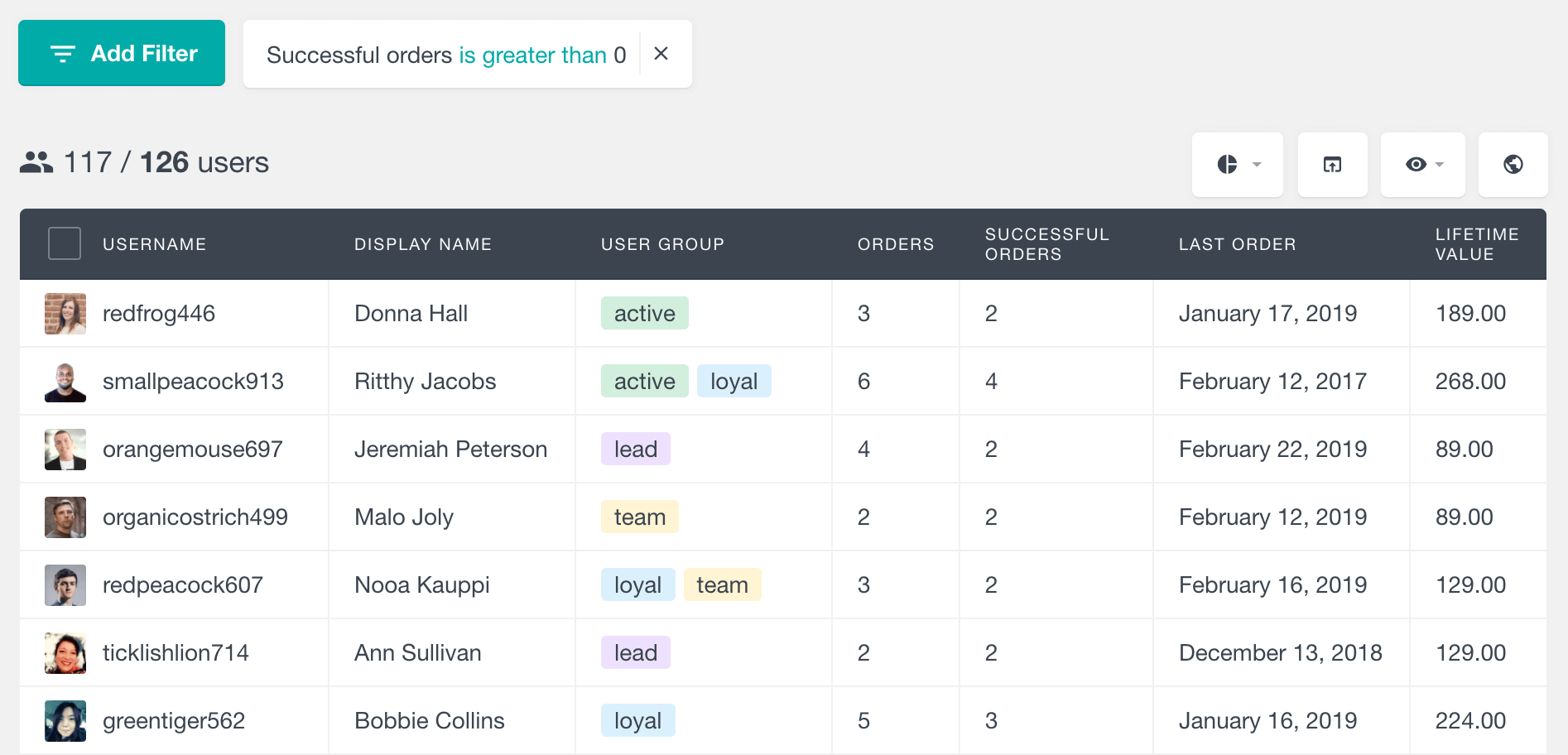
In this example, the proportion of repeat customers is 74 to 117, which comes to 63% overall.
But this information can be explored even further. You may want to know the proportion of your WooCommerce new vs. returning customers in the last 30 days. As we mentioned earlier, there are many ways to tackle this issue. We’ll use the “Placed an order” filter in this example. Here are the filters to find the new vs returning customers for the last 30 days (or any other period):
- New customers in the last 30 days: “Placed a completed order in the last 30 days” (14 users)
- Returning customers in the last 30 days: “Placed a completed order in the last 30 days” + “Placed an order more than 30 days ago” (9 users)
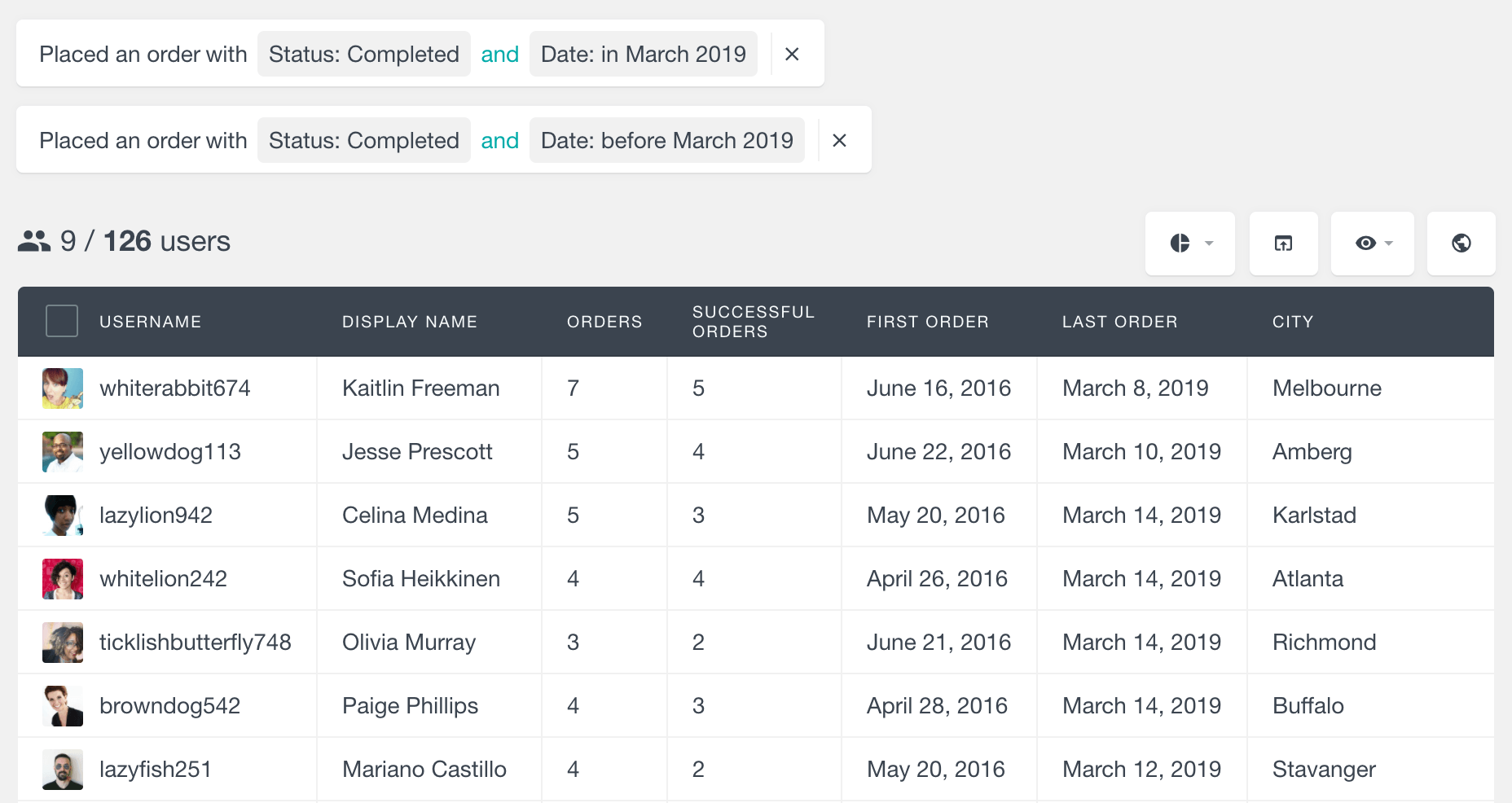
So, in this case, we’ll divide nine returning customers by 14 and find a 64% proportion. This means that for orders made in the last month, our repeat purchase ratio is 64%.
You can also take other approaches to finding how many WooCommerce customers are returning vs. one-time. For instance, you may filter out users based on their registration date. This will show you your repeat purchase ratio for customers registered only in the past month.
Another idea is filtering users by their lifetime value. For example, for your most profitable customers, how many of them are new, and how many are returning? Now, the sky is the limit; you can choose many other ways to slice up your data and get a better understanding of your returning customer profile.
You can choose many other ways to slice up your data and get a better understanding of your returning customer profile.
This kind of information about your customers can be an excellent opportunity to create a marketing campaign for your existing customers. You can easily export the user’s emails using the Users Insights export functionality and set up a few different mailing lists to create a customized offer depending on the type of customer. Targeting your existing customer base is a very effective way to generate more sales – these people have already shown interest and know about your products. Some of them have already trusted you to make a purchase, so providing them an extra incentive to purchase again should result in reasonable conversion rates.
Here is a short video demonstrating how you can find your WooCommerce returning customers with Users Insights:
WooCommerce inactive customers
By comparing the number of orders made in a specific period, Users Insights allows you to analyze your WooCommerce customers list to find new, inactive, and returning customers on your WooCommerce store. New customers will be the recently registered WordPress users who still haven’t made a single purchase. For example, you can list the new customers by adding a filter, “Order number is 0” and a second filter, “Date registered were less than one month ago”.

Inactive customers registered long ago but have yet to make any orders. To get the list of inactive customers, you can add a filter “Order number is 0,” and the date registered is more than 60 days ago.

If you want to turn this customer into active, consider implementing a customer win-back strategy.
WooCommerce Returning Customers
With Users Insights, there are many ways to find your returning customers. Let’s see some examples of how you can do this.
1. Returning customers based on order number
One of the easiest ways to find your returning customers is to use the number of orders field. All you need to do is add one of the following filters: “Successful order number is greater than 1” or “Order number is greater than 1.” Using the successful order number is more accurate, as it only reflects orders with a completed or pending status. The Orders filter, on the other hand, will count all orders, including failed and canceled orders.
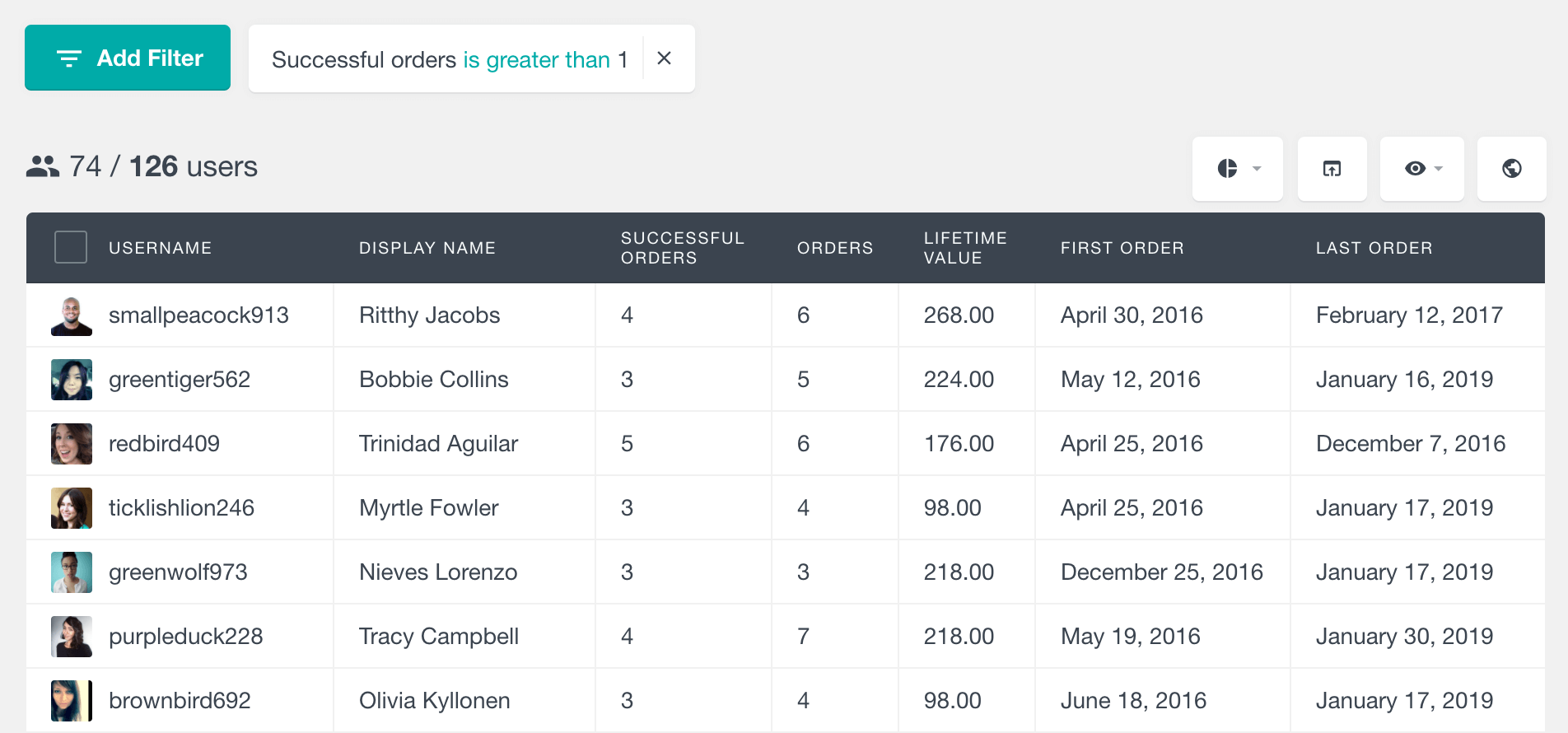
2. Using the “Placed an order” filter
Another way to find your returning customers is by searching their orders directly with the “Placed an order” filter. With this filter, you can find all customers who have placed an order meeting all the criteria applied, allowing you to specify more customizable conditions. In this way, for example, you can easily find all returning customers who have ordered in a given period (e.g., last month). This can be accomplished by finding all customers who have placed a completed order in the given period and also placed an order in the period beforehand:

3. Using the “First order” and “Last order” date filters
Another way to find returning customers based on date is by using the “First order” and “Last order” date filters. One thing to remember with this filter is that first/last order date fields reflect orders with any statuses.
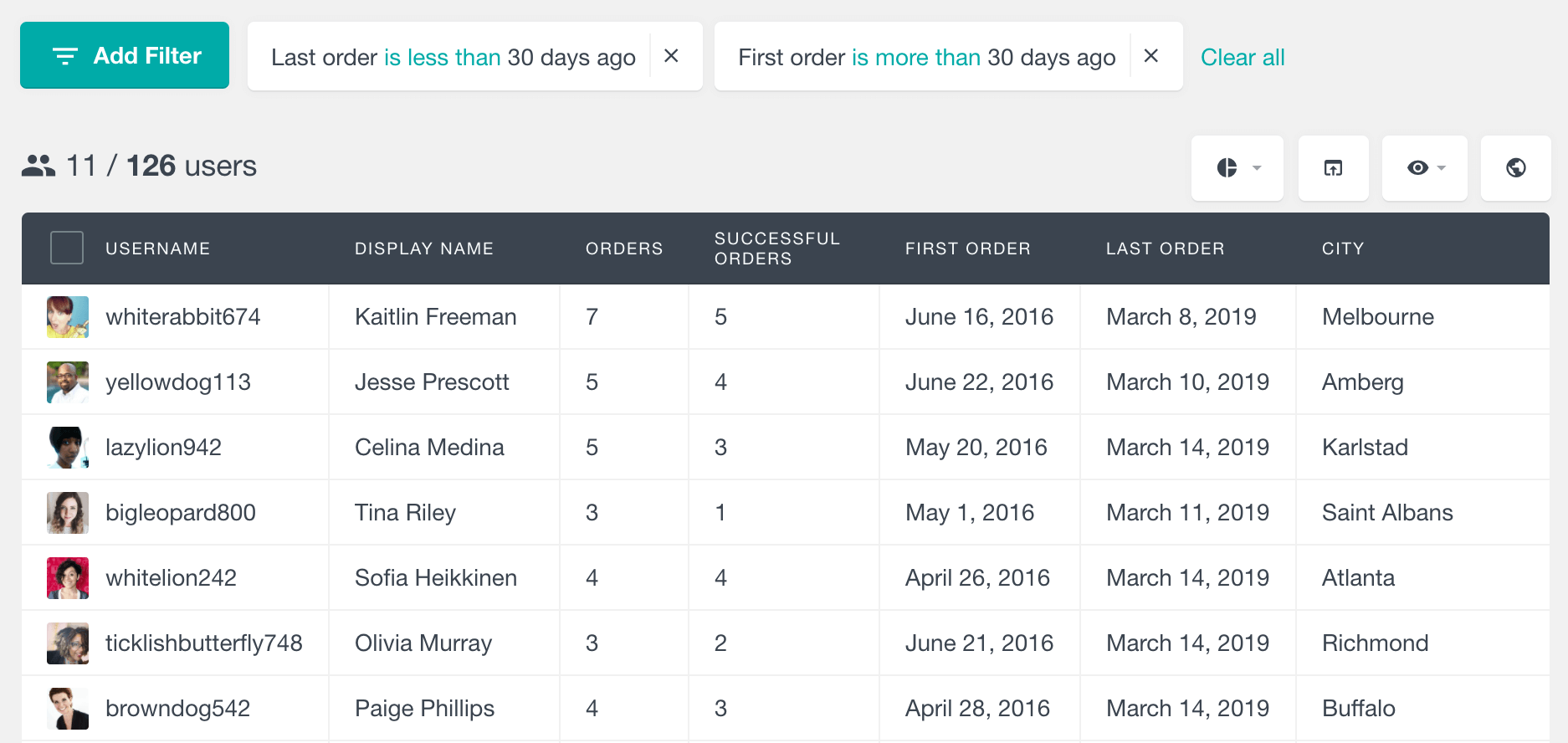
All three methods can help you find your returning customers, and the best method to use would depend on your goal and particular setup.
Additionally, you can click on the Number of Orders field in the Users Insights table. You can sort the list of returning customers by their number of orders, which will give you a quick overview of your most loyal customers.
Once you have the list of returning customers, you can click on a name to see a complete list of orders that particular user has made.
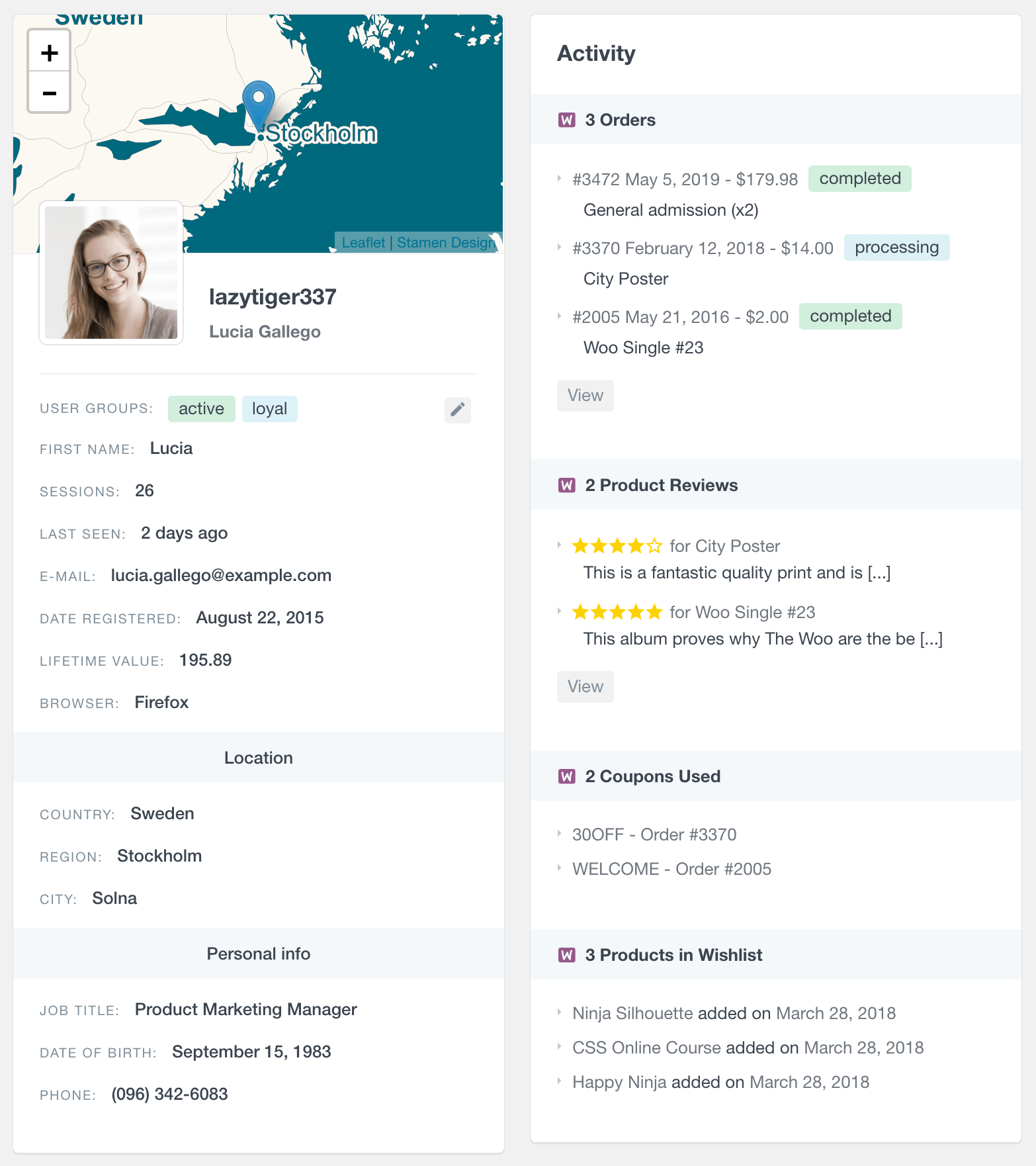
Another example would be to find all the users that have made exactly 2 purchases since we know (from the studies mentioned above) that these customers are more likely to buy again. We can do this by adding a filter with several orders of precisely 2.
According to RJMetrics research, most customers spend (over 69%) in the first 30 days after the first purchase. This means the window for effectively re-engaging a first-time buyer is within the first thirty days.
Tracking customer engagement
If your business is more oriented toward digital products like online courses, memberships, and subscriptions, your customer retention will depend on how much your customers engage with your digital products. This will indicate your customer satisfaction and the likeliness of them continuing their subscription payments. For situations like these, you can use the page visits tracking feature of Users Insights to monitor your customer engagement:
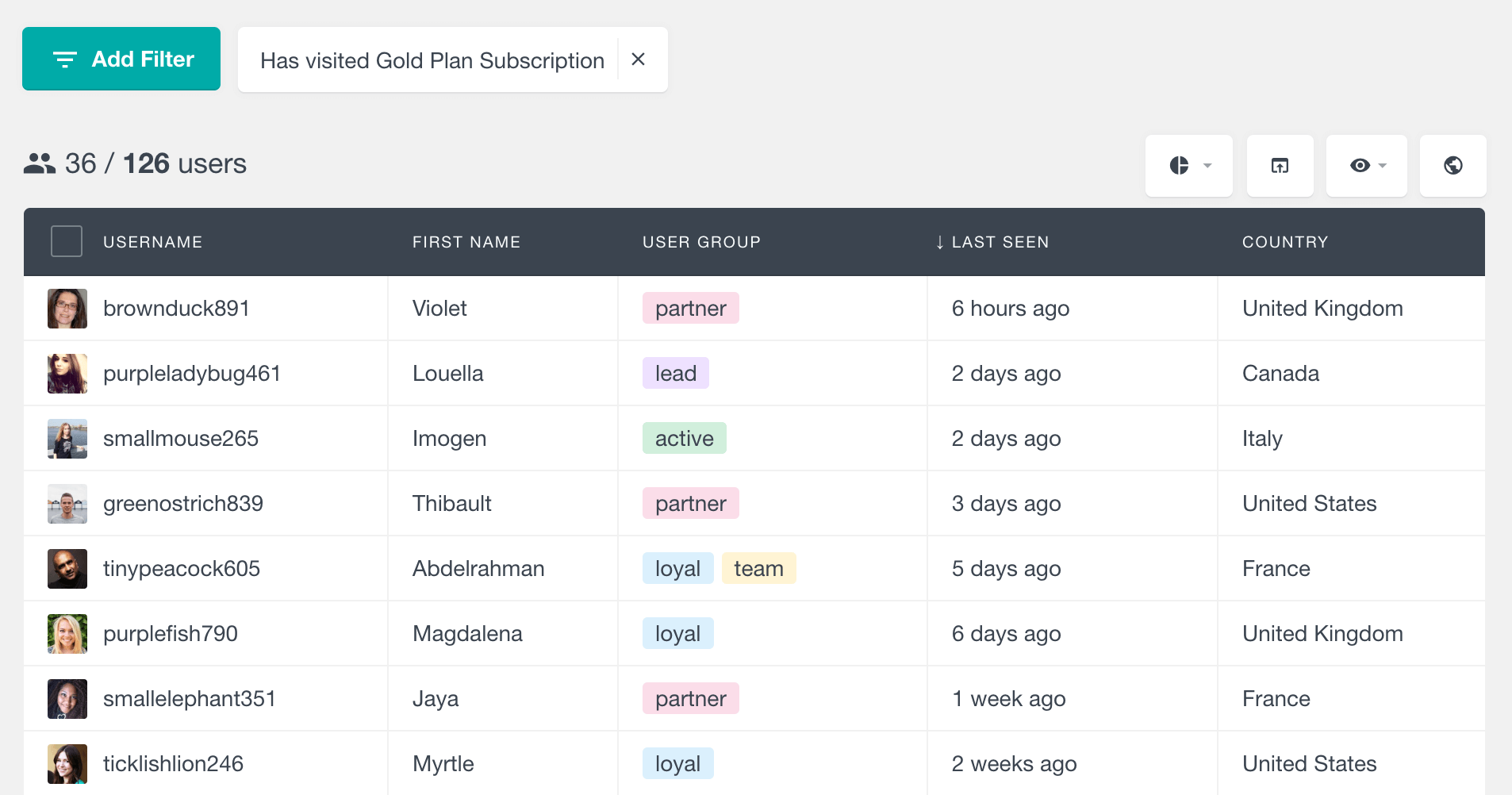
What is an excellent returning customer rate for a WooCommerce store?
According to a study by Shopify, the average returning customer rate for a Shopify store is approximately 27%. However, this metric can vary widely depending on the industry, product offering, customer demographics, and other factors. It is essential to focus on increasing your company’s new customer acquisition while ensuring that your current customers are satisfied and that you develop a strong customer relationship. To generate more returning customers, you can consider implementing strategies such as offering sales and discounts, loyalty rewards, and occasional treats.
What is customer return rate?
Return rate is the percentage of customers who buy again over a certain period, it’s a measure of customer loyalty and satisfaction. It’s a key metric to know how well you’re retaining your customers and to inform your customer retention strategies.
What is a good customer return rate?
A good return rate is between 20% to 40% depending on the industry. Higher is better, means customer is loyal and you’re doing well on retention, means customer is satisfied and will buy again.
Improving WooCommerce customer retention
Finding the returning customers rate should be just the tip of your customer retention marketing strategy. By customer retention, we usually mean efforts and metrics to keep current customers satisfied. Usually, we consider that we have retained a customer for as long as they consider our products their desired solution.
This goes beyond the cold numbers and reaches the customer relationship itself.
These metrics are important because loyal customers are the backbone of any company. They usually support a product line or even test your new products. Often, engaged customers provide feedback and ideas. In addition, they can provide recommendations, referrals, and testimonials, which is the most effective form of marketing.
We consider that we have retained a customer for as long as they consider our products or services as their desired solution.
When it comes to measuring customer loyalty analytics, it depends. Usually, for subscription-based businesses, we measure how long a customer has been a customer. Other important factors, such as upgrades and months above average, are also important. In other words, how long has this customer subscribed compared to the average customer? This critical metric shows you what you are doing differently to keep these long-lasting relationships.
The repeat purchase ratio is usually a good metric for one-time services or products. In addition, you should consider other metrics, such as the customer’s lifetime value and the average buying cycle. The average buying cycle is good for predicting how long it takes between two orders.
There are many ways to improve your customer retention metrics. In general, strategies fall into a few types:
- Communication: Better feedback for customer issues and listening to their concerns
- Customer Support: A branch of communication, but too important to be on its own. Usually, your customer support defines the entire dynamic of your customer relationship, from cheap-impersonal to a deep, meaningful connection. Customers are four times more likely to move to a competitor if they experience customer support issues.
- Improving Products and Services: Better products or unique products for current customers. The exclusivity factor is also certainly a great strategy. Generally, it would be best to try making decisions simple for your customers.
- Proactiveness: If you feel like a customer is inactive or indifferent, try to win them back. Being proactive is a great way to restore a relationship and maintain customer satisfaction and retention.
- Marketing: Instead of giving prizes to new sign-ups, why not do this for long-time customers? For instance, a discount for existing customer via email marketing or on the checkout page, a loyalty program, some free samples, and gifts on their repeat purchases. When we think that relationship marketing is much cheaper, these strategies seem inexpensive.
